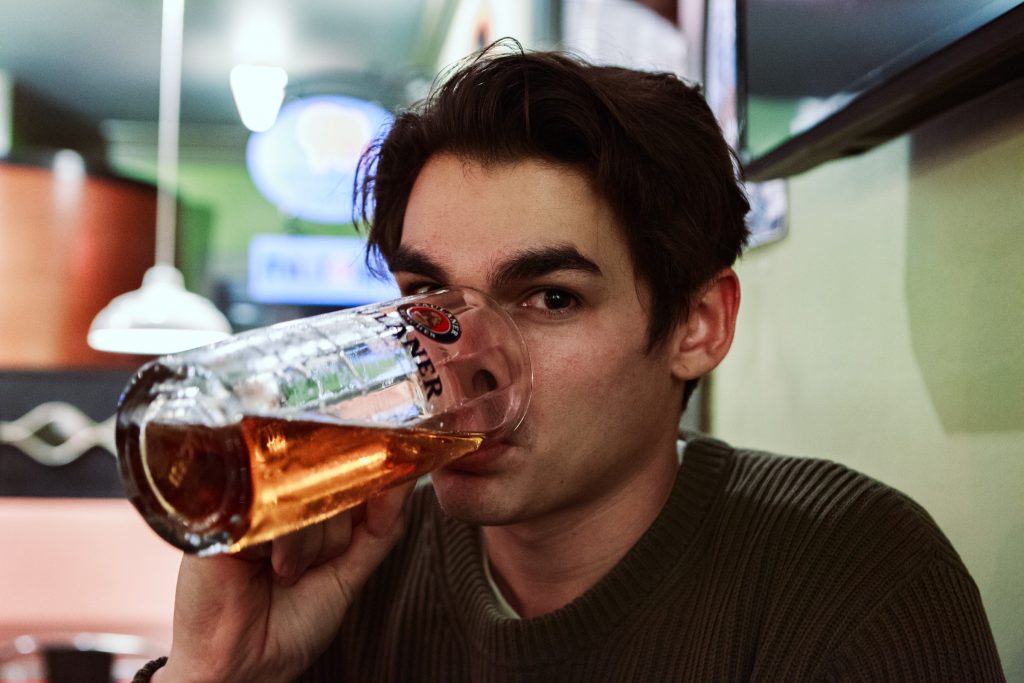107 A Healthy but Risky Time
Martha Lally; Suzanne Valentine-French; and Dinesh Ramoo
Doctor’s visits are less frequent in early adulthood than for those in mid-life and late adulthood and are necessitated primarily by injury and pregnancy (Berger, 2005). However, the top five causes of death in emerging and early adulthood are non-intentional injury (including motor vehicle accidents), homicide, suicide, cancer ,and heart disease (Heron and Smith, 2007). Rates of violent death (homicide, suicide, and accidents) are highest among young adult males, and vary by race and ethnicity. Rates of violent death are higher in the United States than in Canada, Mexico, Japan, and other selected countries. Men are three times more likely to die in motor vehicle accidents than are women (Frieden, 2011).
Alcohol Abuse
A significant contributing factor to risky behaviour is alcohol consumption. According to the 2014 National Survey on Drug Use and Health (National Institute on Alcohol Abuse and Alcoholism, 2015), 88 percent of people ages eighteen or older reported that they drank alcohol at some point in their lifetime; 71 percent reported that they drank in the past year; and 57 percent reported drinking in the past month. Additionally, 6.7 percent reported that they engaged in heavy drinking in the past month. Heavy drinking is defined as drinking five or more drinks on the same occasion on each of five or more days in the past thirty days. Nearly 88,000 people (approximately 62,000 men and 26,000 women) die from alcohol-related causes annually, making it the fourth leading preventable cause of death in the United States. In 2014, alcohol-impaired driving fatalities accounted for 9,967 deaths (31 percent of overall driving fatalities).
The National Institute on Alcohol Abuse and Alcoholism defines binge drinking when blood alcohol concentration levels reach 0.08 g/dL. This typically occurs after four drinks for women and five drinks for men in approximately two hours. In 2014, 25 percent of people ages eighteen or older reported that they engaged in binge drinking in the past month. According to the National Institute on Alcohol Abuse and Alcoholism (2015, p.1), “Binge drinking poses serious health and safety risks, including car crashes, drunk-driving arrests, sexual assaults, and injuries. Over the long term, frequent binge drinking can damage the liver and other organs.”
Alcohol and College StudentsResults from the 2014 National Survey on Drug Use and Health demonstrated a difference between the amount of alcohol consumed by college students and those of the same age who are not in college (National Institute on Alcohol Abuse and Alcoholism, 2016). Specifically, 60 percent of full-time college students (aged eighteen to twenty-two) drank alcohol in the past month compared with 51.5 percent of other persons of the same age not in college. In addition, 38 percent of college students engaged in binge drinking (that is, five or more drinks on one occasion in the past month) compared with 33.5 percent of other persons of the same age. Lastly, 12 percent of college students engaged in heavy drinking (that is, binge drinking on five or more occasions consecutively in the past month). This compares with 9.5 percent of other emerging adults not in college. The consequences for college drinking are staggering, and the National Institute on Alcohol Abuse and Alcoholism (2016) estimates that each year the following occur:
The role alcohol plays in predicting acquaintance rape on college campuses is of particular concern. “Alcohol use Is one of the strongest predictors of rape and sexual assault on college campuses” (Carroll, 2016, p. 454). Krebs, Lindquist, Warner, Fisher and Martin (2009) found that over 80 percent of sexual assaults on college campuses involved alcohol. Being intoxicated increases a woman’s risk of being the victim of date or acquaintance rape (Carroll, 2007). Women are more likely to blame themselves and to be blamed by others if they were intoxicated when raped. College students view perpetrators who were drinking as less responsible, and victims who were drinking as more responsible for the assaults (Untied, Orchowski, Mastroleo, and Gidycz, 2012).  Factors affecting college students’ drinking: Several factors associated with college life affect a student’s involvement with alcohol (National Institute on Alcohol Abuse and Alcoholism, 2015). These include the pervasive availability of alcohol, inconsistent enforcement of underage drinking laws, unstructured time, coping with stressors, and limited interactions with parents and other adults. Due to social pressures to conform and expectations when entering college, the first six weeks of freshman year are an especially susceptible time for students. Additionally, more drinking occurs in colleges with active Greek systems and athletic programs. Alcohol consumption is lowest among students living with their families and commuting, while it is highest among those living in fraternities and sororities. College strategies to curb drinking: Strategies to address college drinking involve the individual and campus community as a whole. Identifying at-risk groups, such as first-year students, members of fraternities and sororities, and athletes has proven helpful in changing students’ knowledge, attitudes, and behaviour regarding alcohol (National Institute on Alcohol Abuse and Alcoholism, 2015). Interventions include education and awareness programs, as well as intervention by health professionals. At the college level, reducing the availability of alcohol has proven effective by decreasing both consumption and negative consequences. |
Non-alcohol substance use: Illicit drug use peaks between the ages of nineteen and twenty-two and then begins to decline. Additionally, 25 percent of those who smoke cigarettes, 33 percent of those who smoke marijuana, and 70 percent of those who abuse cocaine began using after age seventeen (Volkow, 2004). Emerging adults (eighteen to twenty-five) are the largest abusers of prescription opioid pain relievers, anti-anxiety medications, and ADHD medication (National Institute on Drug Abuse, 2015). In 2014, more than 1,700 emerging adults died from a prescription drug overdose. This is an increase of four times since 1999. Additionally, for every death there were 119 emergency room visits.

Daily marijuana use is at the highest level in three decades (National Institute on Drug Abuse, 2015). For those in college, 2014 data indicate that 6 percent of college students smoke marijuana daily, while only 2 percent smoked daily in 1994. For non-college students of the same age, the daily percentage is twice as high (approximately 12 percent). Additionally, daily cigarette smoking is lower for those in college as only 13 percent smoked in the past month, while for those not in college it was almost 25 percent.
Rates of violent death are influenced by substance use, which peaks during emerging and early adulthood. Drugs impair judgment, reduce inhibitions, and alter mood, all of which can lead to dangerous behaviour. Reckless driving, violent altercations, and sexual assault are some examples. Drug and alcohol use increase the risk of sexually transmitted infections because people are more likely to engage in risky sexual behaviour when under the influence. This includes having sex with someone who has had multiple partners, having sex without the use of a condom, having multiple partners, or having sex with someone whose history is unknown. Lastly, as previously discussed, drugs and alcohol ingested during pregnancy have a teratogenic effect on the developing embryo and fetus.
Media Attributions
- Figure 7 8 © Hayes Potter is licensed under a Public Domain license
- Figure 7.9: Illicit drug use in early adulthood. © Greta Schölderle Møller is licensed under a Public Domain license

